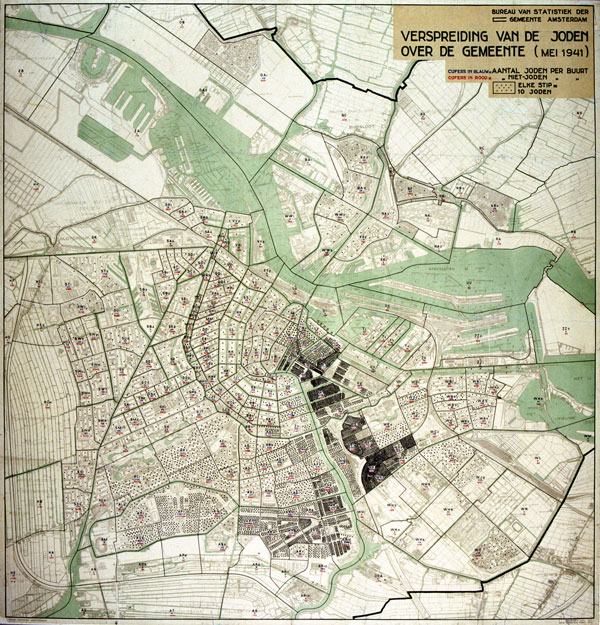Despite their neutrality, the Netherlands were occupied by German troops in May 1940. The royal family and the cabinet fled to Great Britain. Shortly afterwards, a supervisory administration of about 2,000 officials was established under the Reich Commissioner Arthur Seyß-Inquart and his four General Commissioners. Even though the Low Countries had a long history of religious tolerance, anti-Jewish measures were quickly enforced. These were accompanied by brutal street violence by both the German police and army officials and Dutch Nazis, the NSB. The German authorities even set up a “Jewish District” in Amsterdam – the only Ghetto in occupied Western Europe.

Map of “Distribution of Jews in the city” by the statistics office of the city of Amsterdam, May 1941, © NIOD
The registration of Jews in the Netherlands
In the course of planning the Ghetto, the municipal officials had already counted all citizens of the Jewish faith in Amsterdam and marked the numbers on a map. Yet the aim of the Nazis was not just to persecute practicing Jews, but everyone whom they regarded as being of the Jewish "race", calculated on the basis of the religious affiliation of their grandparents. After long discussions, all inhabitants of the Netherlands with just one Jewish grandparent were registered in 1941. Although this went beyond the categories used in Germany, this number (160,800) was included in the protocol of the Wannsee Conference. It was decided during the conference, however, not yet to deport people with one Jewish grandparent, or with two Jewish grandparents who had neither been married to a Jew, nor born into a Jewish marriage, nor been member of a Jewish congregation.
Systematic murder
Nonetheless, the data of the remaining 140,000 registered Jews was used to plan and implement the deportations. After their registration forms had been marked and their IDs stamped with a "J", any official – whether a Dutch policeman or a German SS guard – could easily ascertain whether or not any passerby was Jewish. This made escape very difficult. In the end, 107,000 Jews were deported, of whom approximately 102,000 were murdered – a much higher death toll than in any other Western European country. In Belgium, where the German army was in command and registration was far less systematic, "only" 28,952 of the approximately 64,000 Jews were murdered.











